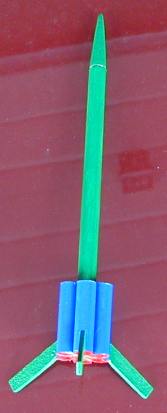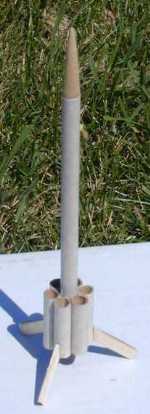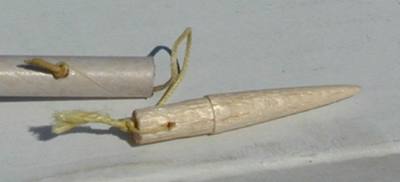![[Picture]](/images/archive/images/ratings/rating_nano_cougar.gif) (09/03/01) At NARAM-43 I decided to purchase a couple of Nano Rockets to
build up and use with our Quest MicroMaxx system to give us a bit of variation.
One of the kits I bought was the Cougar. This is a tube-fin with fin rocket
that has an "interstellar space" story behind it. I'll let you read
that in the instructions or on Nano's website. In the meantime, let me tell you
how this little kit went for me.
(09/03/01) At NARAM-43 I decided to purchase a couple of Nano Rockets to
build up and use with our Quest MicroMaxx system to give us a bit of variation.
One of the kits I bought was the Cougar. This is a tube-fin with fin rocket
that has an "interstellar space" story behind it. I'll let you read
that in the instructions or on Nano's website. In the meantime, let me tell you
how this little kit went for me.
The kit comes with a Kevlar®
shock cord, six (6) 1-3/32" ramscoops, a 5" body tube, a wood nose
cone, three (3) laser-cut balsa fins, and two (2) brass launch lugs. The
 instructions are on a single 9x11"
sheet of paper and the whole thing is packaged in a 8½x6"
envelope.
instructions are on a single 9x11"
sheet of paper and the whole thing is packaged in a 8½x6"
envelope.
CONSTRUCTION:
The instructions tell the story of the Cougar, tell you that you need CA glue (as a minimum), and then step you through construction with some computer generated graphics.
First thing I must do is apologize to Nano for not following the instructions, but going forward I'll explain where I deviated and I will give the benefit of doubt to Nano for some of my observations, based on how I built the rocket.
In step 1, the instructions indicate that you are to glue the Kevlar® shock cord into the hole in the nose cone. My nose cone did not have a hole, and so I created my own connection by drilling a 1mm hole through the shoulder, grooved it horizontally and then tied the shock cord through the hole (see picture below).
In step 2, the assembly of the tube-fins and then the attachment of the balsa fins to them takes place. Here is where I deviated (just because I was building fast and failed to look at the illustrations). I glued the six (6) tubes together in pairs as described. I then glued them onto the main body tube even with the bottom. These should have been up by ¼" per the instructions. I then glued the fins onto every other tube aligned with the bottom of the tube. The instructions have you glue these fins in the grooves of two attached tube-fins. Note that step 2 indicates that the fins should be "midway" up on the tube-fins.
 In step 3, Nano
indicates that this is the hardest step and that is the attachment of the shock
cord to the inside of the body tube. After several attempts with the method
outlined, I drilled a small hole in the side of the body tube, fed the
remaining end of Kevlar®
through it and knotted it. Works for me!
In step 3, Nano
indicates that this is the hardest step and that is the attachment of the shock
cord to the inside of the body tube. After several attempts with the method
outlined, I drilled a small hole in the side of the body tube, fed the
remaining end of Kevlar®
through it and knotted it. Works for me!
 Also in step 3, the launch
lugs are glued on. My launch lugs were not the correct diameter for the
standard MicroMaxx rod, so I was stuck... or was I? I used a 1/16" drill
and drilled out the gap between two of the tube-fins and body tube to make a
place for the rod to slide through. (see the larger hole at 3:00 in the
picture)
Also in step 3, the launch
lugs are glued on. My launch lugs were not the correct diameter for the
standard MicroMaxx rod, so I was stuck... or was I? I used a 1/16" drill
and drilled out the gap between two of the tube-fins and body tube to make a
place for the rod to slide through. (see the larger hole at 3:00 in the
picture)
In general the instructions are adequate, however, they need a bit of clean up (editing and spell checking) to give them more of a professional finish. They are thorough for flying instructions and I did learn a couple of nice tips on flying the MicroMaxx kits in general. My favorite is using a "Z" bent rod to allow alignment of the motor to the ignitor.
I didn't paint my rocket even though the instructions give some direction in this area. I figured, these little guys take such a beating that there was no sense in finishing it.
Overall, for CONSTRUCTION I would rate this kit 2 ½ points. Bottom line is that the nose cone did not fit the instructions description, the shock cord mounting method is too challenging and the launch lugs did not fit the standard Quest rail. Now, let's put this in perspective. I adapted methods that still had it assembled and flying within 1/2 hour. If Nano spends just a few more minutes and addresses these issues and the editing of the instructions this rocket's rating will go higher. There are nice flying tips and the parts are all of good quality.
FLIGHT/RECOVERY:
I flew the rocket three times initially.
First, I believe if I had followed the instructions by having my tube-fins ¼" higher on the tube and the fins in the center of the tubes, then placing it on the MicroMaxx wouldn't have been an issue. My way made the fins get in the way of the base causing me to have the motor out by about a ¼".
The first flight came off the pad fine and gained about 25 feet of altitude doing at least one loop. It ejected and was recovered.
The second flight came off the pad nice and straight and it traveled to guessing 35 feet before the ejection pop and then diving, with the nose cone in place, to stick in the sod. No damage.
The third flight also did a loop or two, ejected and was recovered.
I feel the flight stability is due to my positioning of the tubes and fins and therefore I added some nose weight (a nail into the nose cone from the underside of the shoulder) and tried again. This nail moved my CG to 10.3cm (from the NC) from 11.4cm without the nail.
This forth flight was very stable and went to about 60 feet (I jest against the height of our house), ejected and recovered. That seemed to do the trick.
A few days later, I flew it on MicroMaxx-II motors and I was clearly getting stable and 90-100 feet flights. But my nose cone wasn't ejecting so I have sanded the shoulder more.
For FLIGHT/RECOVERY, I would rate this kit 4 ½ points. Not taking anything away for my building defects, I think this little bird flew nice. It loses some because of the friction fit of the motors. I believe a thrust ring and clip are possible and in order.
Overall, the Cougar is as good as any of the MicroMaxx pre-built rockets in performance. I mean really, only Raw Fusion and Vector seem to give the most consistently straight and stable flights, while the Saturn V has given some wonderful loops. Nano has a niche here that we would love to see them dedicate some time to and enhance their kits and improve the quality. Good job and I look forward to building a couple more. I give the kit an OVERALL rating of 3 points.
Sponsored Ads
 |
 |











